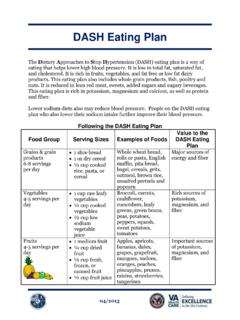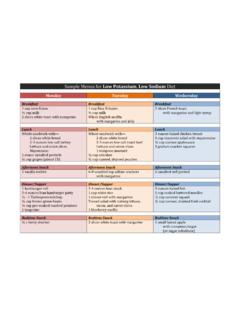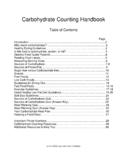Transcription of Conservation of Momentum: Marble Collisions
1 Created by LABScI at Stanford 1 Conservation of Momentum: Marble Collisions Teacher Version In this lab you will roll a Marble down a ramp, and at the bottom of the ramp the Marble will collide with another Marble . You will measure the speed of each Marble before and after the collision to determine whether momentum is conserved in this system for Collisions between marbles of varying relative masses. Preparation and Lab Notes: Download and get familiar with Audacity before using it in the lab. Prerequisites: There is a great deal of computation in the lab. Most students should be able to manage it with a calculator. For the advanced lab students should be comfortable with Algebra California Science Content Standards: 2. Conservation of Energy and Momentum: The laws of Conservation of energy and momentum provide a way to predict and describe the movement of objects.
2 2d. Students know how to calculate momentum as the product mv. 2e. Students know momentum is a separately conserved quantity different from energy. 2f. Students know an unbalanced force on an object produces a change in its momentum. 2g. Students know how to solve problems involving elastic and inelastic Collisions in one dimension by using the principles of Conservation of momentum and energy. Complete List of Materials: For each group (2-4 students per group) you will need the following: A smooth, flat surface Wall 2 grooved rulers OR 2 paper towel tubes (these will be the ramps) 1 meter stick 2 marbles of the same size (same mass) 1 Marble with a larger mass than the first two marbles Textbooks or other prop to give ramp height of 5 cm 1 laptop with microphone (either built-in or separately attached) and the program Audacity installed (see instructions on downloading and installing Audacity below) Electronic Scale or Rudimentary scale: o 3-hole punched ruler with 1 piece of string 10 cm long attached to each hole, and one plastic sandwich bag attached to a string at each end of the ruler o One pack of jelly beans Created by LABScI at Stanford 2 Key Concepts.
3 Velocity is the rate of change of an object s position over time. Momentum is the quantity of motion an object has, given by the product of an object s mass and velocity. The momentum of a system is conserved in a collision. Kinetic energy is the energy an object in motion has. An elastic collision is a collision between at least two objects in which the total kinetic energy is conserved. In an inelastic collision, on the other hand, some kinetic energy is lost to other forms of energy or processes but the total momentum is still conserved. Introductory Mini-Lecture: A vector is a quantity that has both size and direction. The most common example of a vector quantity is velocity. Velocity is the rate of change of an object s position over time. The size of the velocity vector is the speed of the object (for example, 15 miles per hour), while the direction of the vector indicates which way the object is traveling.
4 Mathematically, velocity = distance / time, or symbolically, v = x/ t. The typical units of velocity are meters per second (m/s). Momentum is the quantity of motion an object has, given by the product of an object s mass and its velocity. Mathematically, momentum = mass x velocity, or symbolically, p = m v. The typical units of momentum are kilogram-meters per second (kg m/s). Because velocity is a directional quantity, momentum also has a direction associated with it and is thus a vector. If an object is in motion, it has momentum because all objects have mass and momentum equals mass times velocity. For this reason, momentum is often referred to as mass in motion. More intuitively, we can think of the amount of momentum an object has as expressing how hard it is to stop that object. We know from personal experience that the heavier something is or the faster something is moving, the harder it is to stop in other words, the more momentum that object has.
5 For example, even a car moving very slowly is extremely difficult to stop in its tracks; even though the car s velocity is small, its mass is very large, so moving cars have a lot of momentum even at slow speeds. The most important thing to remember about momentum is that momentum is conserved. This means that the total momentum of a system never changes; it is always the same. So, for example if one object collides with another, the momentum of that object doesn t just disappear its momentum is transferred to the object it collides with. Kinetic energy is the energy an object in motion has. Mathematically, kinetic energy = (one-half) mass x velocity (squared), or symbolically, KE = ( )mv2. An elastic collision is a collision between at least two objects in which the total kinetic energy is conserved; it remains the same before and after the collision, because the objects velocities relative to each other are switched after the collision.
6 For example, if an object in motion collides with an object at rest, it comes to a complete stop and transfers all of its velocity to the object at rest, causing the latter to move at the same velocity with which it was hit. Meanwhile, an inelastic collision is a collision between at least two objects in which some kinetic energy is lost to other forms of energy or processes (heat, friction, etc.), but the total momentum is still conserved. Created by LABScI at Stanford 3 Instructions for downloading and installing Audacity: 1. Go to the website < > 2. Click on Download Audacity , unless you run Windows Vista or Windows 7, in which case you should click on Download Audacity (Beta). 3. Download the appropriate version for your type of computer (PC, Mac, or Linux/Unix). 4. Once you click on the appropriate link, click Save to Disk. Follow the Installation Instructions on that website.
7 Click on the Audacity icon to launch the application. 5. Make sure the microphone is working by clicking the record button and tapping the table next to the computer a few times. To delete the recording, go to Edit Undo. Instructions for measuring the mass of the marbles if you don t have an electronic scale using an improvised scale: 1. If you uses the jelly bean scale hold your balance by the middle string. The weights in both bags are equal when the ruler is straight. 2. Insert one small Marble into one of the sandwich bags. 3. Insert a couple of jelly beans into the second bag. 4. Add or remove jelly beans to/from the second bag until the ruler is straight. You are finding the Marble s mass in terms of jelly beans. Record the mass of the marbles. Note: For this situation of the lab, we ll be working with the marbles that are the same size, so in the table below, the mass of top Marble should equal the mass of bottom Marble .
8 ** 1 jelly bean = 1 gram ** Marble # of jelly Beans Mass (g) Top Bottom Created by LABScI at Stanford 4 Part 1 Equal Masses In this first part, you will determine whether momentum is conserved for a collision between two marbles of equal masses. 1. Measure the mass of one Marble using an electronic scale. Note: For this situation of the lab, we ll be working with the marbles that are the same size, so in the table below, the mass of the top Marble should equal the mass of the bottom Marble . 2. Place textbooks (or other props) on a smooth, flat surface, such as a floor or table, approximately 1 m away from wall. With a meter stick, give them a height of 5 cm. 3. Lean a grooved ruler or paper towel tube against the textbooks (or other props) so that the top end is at the 5 cm height while the other end is touching the floor. The ramp should be positioned so that the Marble rolled down the ramp will roll across the floor and collide with the wall.
9 4. Tape down the top of the ramp onto the textbooks/props (if needed). 5. Place the Top Marble at the top of the paper towel tube ramp. 6. Place the Bottom Marble at the bottom of the ramp, directly in the path of where the first Marble will roll. 7. Measure the distance (in meters) from Bottom Marble to the wall that it will eventually hit. Distance to wall: _____ (m) Marble Mass (g) Top Bottom Created by LABScI at Stanford 5 QS1. Which Marble do you predict will have a larger momentum right before they collide at the bottom of the ramp? Explain. Remember momentum The Top Marble will have a greater initial momentum. Momentum is a product of mass and velocity, so if both marbles have equal masses, whichever has a greater velocity will have a greater momentum. The Bottom Marble is stationary until the Top Marble hits it. QS2, QSA1. If momentum is conserved, what do you think will happen when the two marbles make contact with each other?
10 The Bottom Marble has no momentum whatsoever, which means all the momentum comes from the rolling Top Marble . In order for the moving Marble s momentum to be conserved, some of the momentum of the Top Marble should transfer to the unmoving Bottom Marble upon contact, putting the immobile Marble in motion. STUDENT ADVANCED VERSION ONLY and record the initial velocity of each Marble in the table below using the laws of Conservation of energy (the velocity of the stationary Bottom Marble is 0 m/s). to gravitational potential energy (GPE), all unsupported objects fall downward with a gravitational acceleration of m/s2. The total GPE is a product of mass m, gravitational acceleration g, and height h: GPE = mgh of energy states that the Marble s kinetic energy at the bottom of the ramp is equal to its GPE at the top of the ramp. find the velocity v of the rolling Marble , set the two equations equal to each other and solve for the unknown variable v.
















